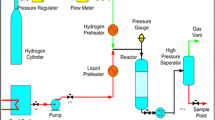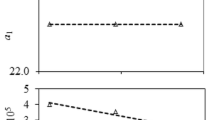Abstract
The mathematical modeling of hydrocracking kinetics of a heavy oil fraction was carried out using the discrete lumping approach and different number of lumps, using all reaction routes among them. We use data previously reported for the implementation of the models; the information used was taken at 663, 683 and 703 K, and LHSV ranging from 0.5 to 3 h−1. For modeling the reaction rate, we use the power law kinetic model, assuming a first order on hydrocarbon concentration. We developed six approaches that represented well the experimental data. Some relevant features of the discrete lumping were observed, such as the slight differences among the overall rate constant from residue to the whole products, and those obtained from summing the contribution of each rate constant from simultaneous reaction of residue to diverse distillates. Close agreement between simulated profiles and experimental data was found for all kinetic model approaches; the maximum error was 1.1 × 10–3 while the minimum was 8.76 × 10–5. Using the rate constants at each temperature and model approach, we obtain the activation energies, and those were of about 105 J/mol.








Similar content being viewed by others
References
bp global (2021) https://www.bp.com. Accessed 3 Oct 2021
Carruthers JE, Waddams AL, Solomon LH (2021) Petroleum refining. Encyclopedia Britannica. https://www.britannica.com/technology/petrolem-refining. Accessed 10 Oct 2021
Peng C, Cao Z, Du Y, Zeng R, Guo R, Duan X, Fang X (2018) Optimization of a pilot hydrocracking unit to improve the yield and quality of jet fuel together with heavy naphtha and tail oil. Ind Eng Chem Res 57(6):2068–2074. https://doi.org/10.1021/acs.iecr.7b04981
Iplik E, Aslanidou I, Kyprianidis K (2020) Hydrocracking: a perspective towards digitalization. Sustainability 12(17):7058. https://doi.org/10.3390/su12177058
Mederos FS, Elizalde I, Ancheyta J (2009) Steady-state and dynamic reactor models for hydrotreatment of oil fractions: a review. Catal Rev 51(4):485–607. https://doi.org/10.1080/01614940903048612
Sapre AM, Krambeck FJ (1991) Chemical reactions in complex mixtures. Springer, USA
Elizalde I, Rodríguez MA, Ancheyta J (2009) Application of continuous kinetic lumping modeling to moderate hydrocracking of heavy oil. Appl Catal A 365(2):237–242. https://doi.org/10.1016/j.apcata.2009.06.018
Ancheyta J, Sanchez S, Rodríguez MA (2005) Kinetic modeling pf Hydrocracking of heavy oil fractions: a review. Catal Today 109:76–92. https://doi.org/10.1016/j.cattod.2005.08.015
Ye L, Liu J, Xing B, Qin X, Yu W, Xie J, Lu D (2021) Molecular-level Reaction network in delayed coking process based on structure-oriented lumping. Chem Eng Sci 246(December):116981. https://doi.org/10.1016/j.ces.2021.116981
Froment GF (2005) Single event kinetic modeling of complex catalytic processes. Catal Rev 47(1):83–124. https://doi.org/10.1081/CR-200047793
Kumar H, Froment GF (2007) Mechanistic kinetic modeling of the hydrocracking of complex feedstocks, such as vacuum gas oils. Ind Eng Chem Res 46(18):5881–5897. https://doi.org/10.1021/ie0704290
El-Kady FY (1979) Hydrocracking of vacuum distillate fraction over bifunctional molybdenum- nickel/silica-alumina catalyst. Indian J Technol 17(1):167–183
MATLAB (2020) version 9.8 (R2020A). Natick, Massachusetts: The MathWorks Inc.
Till Z, Chován T, Varga T (2020) Uncertainties of lumped reaction networks in reactor design. Ind Eng Chem Res 59:10531–10541. https://doi.org/10.1021/acs.iecr.0c00549
Periyasamy B (2015) Solution of linear differential equations in chemical kinetics through flow graph theory approach. J Taiwan Inst Chem Engs 57:9–17. https://doi.org/10.1016/j.jtice.2015.05.002
Zhang Z, Fan LP, Wang YJ (2020) Applications of chemical kinetics in heterogeneous catalysis. Advanced oxidation processes - applications, trends, and prospects. IntechOpen Book Series. https://doi.org/10.5772/intechopen.91939
Shi S, Tan W, Sun J (2016) Progress in kinetic predictions for complex reaction of hydrocarbons: from mechanism studies to industrial applications. Reviews Chem Eng 32(3):363–378. https://doi.org/10.1515/revce-2015-0029
Amhammed MA (2013) Applications of lumping kinetics methodology to complex reactive mixtures. [PhD Thesis] Heriot-Watt University, UK. https://core.ac.uk/download/pdf/77035465.pdf
Till Z, Varga T, Szabó L, Chován T (2017) Identification and observability of lumped kinetic models for vacuum gas oil hydrocracking. Energy Fuels 31(11):12654–12664. https://doi.org/10.1021/acs.energyfuels.7b02040
Messac A (2015) Optimization in practice with Matlab. Cambridge University Press, New York. https://doi.org/10.1017/CBO9781316271391
Acknowledgements
L.A. Soto thanks CONACyT by scholarship for studies of Master of Science at Instituto Politécnico Nacional. Also, partial financial support from research projects CONACyT No. 274276, and SIP-IPN 20211015 and 20210688 is acknowledged.
Author information
Authors and Affiliations
Corresponding author
Additional information
Publisher's Note
Springer Nature remains neutral with regard to jurisdictional claims in published maps and institutional affiliations.
Supplementary Information
Below is the link to the electronic supplementary material.
Rights and permissions
About this article
Cite this article
Soto-Azuara, L.A., Ramírez-López, R., del Carmen Monterrubio-Badillo, M. et al. Mathematical modeling of the hydrocracking kinetics of a heavy oil fraction using the discrete lumping approach: the effect of the variation of the lump number. Reac Kinet Mech Cat 135, 655–667 (2022). https://doi.org/10.1007/s11144-022-02156-3
Received:
Accepted:
Published:
Issue Date:
DOI: https://doi.org/10.1007/s11144-022-02156-3




